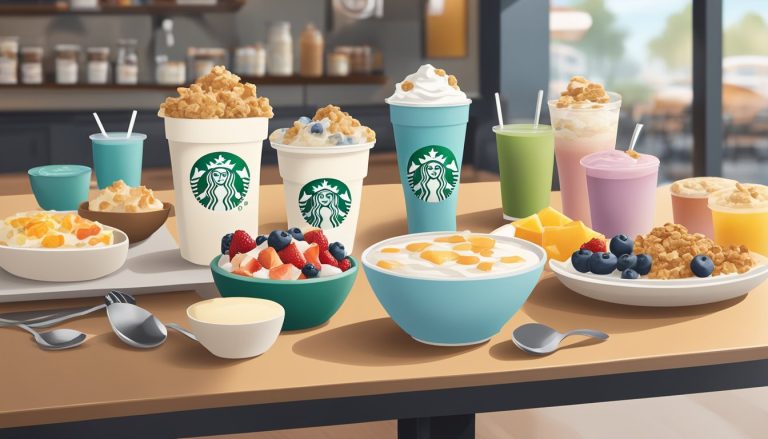Starbucks, the global coffee giant, has long recognized the importance of customer feedback in shaping its offerings. The company’s breakfast menu, a significant part of its product lineup, has evolved over the years based on valuable input from patrons. Customer feedback plays a crucial role in Starbucks’ decision-making process for its breakfast menu, influencing everything from new item introductions to modifications of existing offerings.
The company employs various methods to gather customer insights, including surveys, social media monitoring, and in-store feedback. This information helps Starbucks identify trends, preferences, and areas for improvement in their breakfast selections. By actively listening to customers, the coffee chain can adapt its menu to meet changing tastes and dietary requirements.
Starbucks’ approach to utilizing customer feedback has led to several successful breakfast menu additions and modifications. The company’s willingness to act on customer suggestions has not only improved customer satisfaction but also contributed to increased sales in the breakfast category. This customer-centric strategy continues to be a key factor in Starbucks’ ability to maintain its position as a leader in the competitive coffee and breakfast market.
Understanding the Impact of Customer Feedback

Customer feedback serves as a powerful tool for Starbucks to refine its breakfast menu offerings. It provides valuable insights into customer preferences, pain points, and overall satisfaction with the morning food selections.
The Importance of Customer Opinions
Customer opinions shape Starbucks’ breakfast menu development. Feedback helps identify popular items and uncover areas for improvement. Positive comments reinforce successful offerings, while negative feedback highlights issues to address.
Starbucks actively solicits customer input through surveys, social media, and in-store interactions. This ongoing dialogue ensures the breakfast menu stays aligned with evolving tastes and expectations.
By valuing customer opinions, Starbucks builds trust and loyalty. Customers feel heard and appreciated, leading to increased satisfaction and repeat visits.
Analyzing Feedback for Strategic Insights
Starbucks employs data analysis techniques to extract meaningful insights from customer feedback. This process involves:
- Sentiment analysis to gauge overall satisfaction
- Trend identification to spot emerging preferences
- Demographic segmentation to tailor offerings
By analyzing feedback data, Starbucks can:
- Identify top-performing breakfast items
- Pinpoint areas for menu expansion
- Recognize regional preferences
These insights guide strategic decisions about menu updates, new product launches, and marketing campaigns.
Leveraging Customer Comments for Improvement
Starbucks uses customer comments to drive continuous improvement in its breakfast offerings. Feedback helps refine existing menu items and inspires new creations.
For example, customer requests for healthier options led to the introduction of protein boxes and egg white wraps. Suggestions for more plant-based choices resulted in expanded vegan and vegetarian selections.
Starbucks also addresses specific pain points raised in feedback. This might include adjusting portion sizes, improving food quality, or enhancing packaging for on-the-go convenience.
By actively responding to customer input, Starbucks demonstrates its commitment to meeting customer needs and enhancing the overall breakfast experience.
Starbucks’ Approach to Gathering Feedback
Starbucks employs diverse methods to collect customer feedback, ensuring a comprehensive understanding of consumer preferences. The company utilizes traditional surveys, digital platforms, and innovative mobile solutions to capture insights that shape its breakfast menu offerings.
Surveys and Ratings Methods
Starbucks regularly conducts in-store surveys to gauge customer satisfaction with its breakfast items. These surveys often include rating scales for factors like taste, presentation, and value. The company also employs post-purchase email surveys, targeting customers who recently bought breakfast products.
Feedback forms are available at store counters, allowing customers to share immediate thoughts on their meal experiences. Starbucks analyzes this data to identify trends and areas for improvement in their breakfast menu.
My Starbucks Idea Platform
The My Starbucks Idea platform serves as a digital suggestion box for customers. Users can submit breakfast-related ideas, from new menu items to modifications of existing offerings. Other customers can vote on these suggestions, helping Starbucks prioritize popular concepts.
This crowdsourcing approach has led to the introduction of several successful breakfast items. Starbucks actively engages with users on the platform, providing updates on idea implementations and fostering a sense of customer involvement in menu development.
Mobile Apps and Online Surveys
Starbucks leverages its mobile app to gather real-time feedback on breakfast purchases. The app sends push notifications requesting ratings shortly after transactions, capturing fresh impressions of menu items.
Online surveys linked from receipts or QR codes on packaging provide another avenue for detailed feedback. These digital methods allow Starbucks to collect large volumes of data efficiently.
The company uses advanced analytics to process this information, identifying patterns and preferences that inform breakfast menu decisions. This data-driven approach helps Starbucks tailor its offerings to meet evolving customer tastes and expectations.
Incorporating Customer Feedback Into Menu Innovation
Starbucks utilizes customer feedback to shape its breakfast menu, ensuring offerings align with consumer preferences and market trends. This approach allows the company to create innovative products that resonate with its customer base.
Adapting to Customer Preferences and Trends
Starbucks closely monitors customer preferences and industry trends to guide its menu innovation process. The company analyzes sales data, conducts surveys, and tracks social media conversations to identify emerging flavor preferences and dietary needs. This information helps Starbucks develop new breakfast items that cater to evolving tastes.
For example, noticing a growing demand for plant-based options, Starbucks introduced the Impossible Breakfast Sandwich. This product addresses the needs of vegetarian and flexitarian customers while maintaining the familiar taste and texture of a traditional breakfast sandwich.
Starbucks also uses customer feedback to refine existing menu items. By listening to customer suggestions, the company can make small adjustments to recipes or portion sizes, enhancing overall satisfaction.
Seasonal Offerings and Customer Desires
Seasonal menu items play a crucial role in Starbucks’ strategy to meet customer desires throughout the year. The company leverages customer feedback to create limited-time offerings that generate excitement and drive sales.
The Pumpkin Spice Latte, a fall favorite, exemplifies how Starbucks incorporates customer preferences into seasonal products. Its popularity has led to the expansion of pumpkin-flavored items on the breakfast menu, including the Pumpkin Cream Cheese Muffin and Pumpkin Scone.
Starbucks also uses customer input to determine the timing and duration of seasonal offerings. By gauging customer demand, the company can optimize the availability of these special items, ensuring they remain desirable without overstaying their welcome.
Beverage and Breakfast Item Development
Customer feedback heavily influences Starbucks’ beverage and breakfast item development process. The company uses a combination of in-store tastings, focus groups, and online surveys to gather insights on new product concepts.
For beverages, Starbucks has responded to customer desires for healthier options by introducing lower-calorie alternatives and customizable drink choices. The success of Cold Brew coffee, for instance, stemmed from customer preferences for smoother, less acidic iced coffee options.
In breakfast item development, Starbucks focuses on creating portable, convenient options that cater to on-the-go customers. The Sous Vide Egg Bites, introduced in response to customer requests for high-protein breakfast choices, have become a popular menu staple.
By continuously incorporating customer feedback into its innovation process, Starbucks ensures its breakfast menu remains relevant and appealing to its diverse customer base.
Evaluating Service and Product Quality
Starbucks employs rigorous methods to assess and enhance its service and product quality. The company focuses on maintaining consistency, optimizing store environments, and continuously refining customer experiences.
Ensuring Consistency Across Locations
Starbucks implements strict quality control measures to maintain uniform standards across its global network of stores. Baristas undergo comprehensive training programs to master drink preparation techniques and customer service skills. Regular audits and mystery shopper programs help identify areas for improvement.
The company uses standardized equipment and ingredients to ensure consistent product quality. Automatic espresso machines and precise recipes contribute to drink uniformity. Starbucks also conducts frequent taste tests to verify flavor profiles meet established benchmarks.
Enhancing the Store Environment Experience
Starbucks carefully designs its store layouts to create inviting atmospheres that encourage customer satisfaction and loyalty. Comfortable seating arrangements, warm lighting, and curated background music contribute to a welcoming ambiance.
The company incorporates local cultural elements into store designs to resonate with different communities. Art installations, architectural details, and merchandise displays often reflect regional influences. Cleanliness is prioritized through regular maintenance schedules and staff training on hygiene protocols.
Continuous Improvement of Service Quality
Starbucks actively solicits customer feedback through surveys, social media monitoring, and in-store comment cards. This input helps identify pain points and opportunities for service enhancements. The company analyzes transaction data and customer behavior patterns to optimize store operations and reduce wait times.
Employee feedback is also valued, with regular team meetings and suggestion programs encouraging frontline staff to propose improvements. Starbucks invests in technology solutions like mobile ordering apps to streamline the customer experience. The company frequently tests new service concepts in select markets before broader implementation.
Strengthening Customer Relationships and Loyalty

Starbucks has implemented several strategies to foster strong customer relationships and loyalty through its breakfast menu offerings. These efforts focus on rewarding regular customers, actively engaging with patrons, and addressing concerns promptly.
Starbucks Rewards Program Benefits
Starbucks’ Rewards program offers exclusive perks to frequent breakfast customers. Members earn Stars on purchases, which can be redeemed for free food and drinks. The program provides early access to new breakfast items, allowing loyal customers to try innovations first.
Customized offers based on past breakfast preferences encourage repeat visits. For example, a customer who often orders oatmeal might receive a discount on a new granola parfait. This personalization makes members feel valued and understood.
The tiered system motivates customers to increase their spending to reach higher levels with better rewards. Gold members enjoy free refills on brewed coffee during their visit, a particularly appealing perk for morning patrons.
Active Engagement with Customer Base
Starbucks actively seeks input on its breakfast menu through various channels. The company conducts regular surveys, both in-store and online, to gauge customer satisfaction with current offerings and interest in potential new items.
Social media platforms serve as a hub for customer feedback. Starbucks monitors mentions and hashtags related to its breakfast menu, responding to comments and suggestions. This real-time engagement shows customers their opinions matter.
The “My Starbucks Idea” platform allows customers to submit and vote on breakfast menu ideas. Popular suggestions, like the protein boxes, have been implemented, demonstrating Starbucks’ commitment to customer-driven innovation.
Handling Complaints and Negative Reviews
Starbucks takes a proactive approach to addressing negative feedback about its breakfast menu. The company has a dedicated customer service team trained to handle complaints efficiently and empathetically.
When issues arise, such as quality concerns or menu item availability, Starbucks often offers immediate solutions like replacements or refunds. This swift action helps maintain customer trust and loyalty.
Starbucks uses negative reviews as opportunities for improvement. Feedback about taste, portion sizes, or nutritional content is carefully analyzed and often leads to menu adjustments. This responsiveness shows customers that their opinions directly influence the breakfast offerings.
Corporate Social Responsibility and Ethicality

Starbucks has integrated corporate social responsibility and ethical practices into its core business strategy. These initiatives focus on sustainable sourcing and have a significant impact on how customers perceive the brand.
Promoting Ethical Sourcing and Sustainability
Starbucks implements rigorous standards for ethically sourcing coffee beans. The company works directly with farmers to ensure fair wages and sustainable farming practices. In 2020, 98.6% of Starbucks coffee was ethically sourced through Coffee and Farmer Equity (C.A.F.E.) Practices.
The company also invests in farmer support centers to provide education on sustainable farming methods. This commitment extends to other ingredients, with a focus on responsibly sourced cocoa, tea, and dairy products.
Starbucks aims to reduce environmental impact through initiatives like eliminating plastic straws and developing recyclable cups. These efforts resonate with environmentally conscious consumers.
Impact on Brand Image and Customer Perception
Starbucks’ ethical practices significantly influence its brand image. Customers increasingly value companies that demonstrate social responsibility. A 2021 survey showed that 77% of consumers are more likely to buy from companies committed to making the world a better place.
These initiatives foster customer loyalty. Consumers feel good about supporting a brand aligned with their values. Starbucks’ transparency in reporting its progress on sustainability goals builds trust with customers.
The company’s ethical stance also attracts socially conscious employees, further enhancing customer experiences. This positive cycle reinforces Starbucks’ reputation as a responsible corporate citizen.
Utilizing Customer Interactions in Marketing Strategies
Starbucks leverages customer interactions to refine its marketing strategies and enhance its breakfast menu offerings. The company actively seeks and incorporates customer feedback to create targeted promotions and build brand loyalty.
Incorporating Feedback in Promotional Activities
Starbucks uses customer input to shape its promotional campaigns for breakfast items. The company analyzes feedback on flavors, portion sizes, and nutritional preferences to develop limited-time offers and seasonal specials. For example, customer requests for more plant-based options led to the introduction of vegan breakfast sandwiches in select markets.
Social media engagement plays a crucial role in Starbucks’ marketing efforts. The company monitors trending topics and customer discussions to identify potential new breakfast products or modifications to existing menu items. This real-time feedback allows Starbucks to quickly adapt its offerings and marketing messages to meet changing customer demands.
Customer Reviews as Marketing Tools
Starbucks strategically utilizes positive customer reviews in its marketing materials. The company features satisfied customer testimonials on in-store displays and digital platforms to promote popular breakfast items. These authentic endorsements help build trust and credibility with potential customers.
User-generated content, such as Instagram posts featuring Starbucks breakfast offerings, is often reshared on the company’s official social media accounts. This approach not only showcases the products but also fosters a sense of community among Starbucks’ customers. The company encourages customers to share their experiences by creating branded hashtags and running photo contests centered around breakfast menu items.




